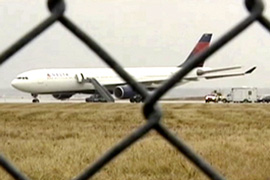Al-Qaeda group claims US plane plot
Statement on website says failed bombing bid was to avenge US operations in Yemen.

The group had earlier said in comments posted on a website that it would take revenge against the US over air raids in Yemen that it claims killed about 50 people.
Failed attack
Umar Farouk Abdulmutallab is accused of trying to to light an explosive device while on a flight from Amsterdam to Detroit.
He was overpowered by passengers on the flight, which had nearly 300 people on board.
| in depth | |||
|
According to a charge sheet prepared by prosecutors, Abdulmutallab tried to bring down the aircraft using a device containing the explosive PETN, also known as pentaerythritol.
The explosive material was allegedly sewn into his underwear.
Al-Qaeda in the Arabian Peninsula said it had provided Abdulmutallab with the device, but that a technical fault prevented it from detonating.
Abdulmutallab, who suffered burns in the incident, was moved from a hospital to a federal prison west of Detroit on Monday.
Janet Napolitano, Obama’s senior security official, said there was “no indication” Abdulmutallab was acting as part of a larger plot and warned against speculating that he had been trained by al-Qaeda.
According to The New York Times, Abdulmutallab told FBI agents he was connected to an al-Qaeda affiliate, which operates largely in Yemen and Saudi Arabia, by a radical Yemeni cleric whom he contacted online.
‘Nothing suspicious’
The Yemeni government said on Monday that Abdulmutallab had lived in Yemen from August to December after obtaining a visa to study Arabic there, but that there was “nothing suspicious about his intentions” to visit the country.
| In video |
|
Al Jazeera talks to a former CIA agent about the growing threat facing air travel |
“Authorities are currently investigating who he was in contact with in Yemen and the results of the investigation will be delivered to those concerned with investigating the terror plot in the United States,” a statement from the Yemeni foreign ministry said.
Ali al-Ahmed, the director of the Institute for Gulf Affairs in the US, said that the attack had similarities with other operations carried out by Al-Qaeda in the Arabian Peninsula, a relatively new branch of al-Qaeda formed in 2008.
“It has carried out several operations – about a year ago against the US embassy in Sanaa, a failed attempt on the Saudi assistant minister of the interior in September.
“In this case, the age of the suicide bomber who tried to kill the Saudi assistant minister – 23 years old – [is] the same age as this young man, Abdulmutallab. And the same explosives [were used].
“In the first attack in Saudi Arabia, the attacker put the bomb inside his body to conceal it. This is very similar.”
Security review
Abdulmutallab, a former student in London, was added to a watch-list of about 550,000 names last month after his father told US embassy officials in Abuja that he was concerned by his son’s increasing radicalism.
 |
| Abdulmutallab is accused of trying to blow up a flight as it landed in Detroit [Reuters] |
But he remained off a short-list of 18,000 names from which the no-fly list of 4,000 is selected and flew from Lagos to Amsterdam on Christmas Eve and on to Detroit the following day with a valid US visa.
Barack Obama, the US president, has ordered a review of how travellers are placed on watch lists and the screening procedures of air passengers following the failed bid to blow up the airliner.
Speaking while on vacation in Hawaii on Monday, Obama said: “We will not rest until we find all who were involved and hold them accountable.”
Obama has also ordered a second review to examine how “an individual with the chemical explosive he had on him could get onto an airliner in Amsterdam and fly into this country,” Robert Gibbs, the White House press spokesman, said.
Bob Baer, a former CIA agent who in 2006 warned that a Northwest Airlines flight from Amsterdam could be the target of an attack, said the attempted bombing had shown that security checks are “not effective at all”.
“It’s not a question of a gaping hole, it’s a question of the terrorist groups evolving their techniques very quickly,” he told Al Jazeera.
“So they’re getting better and better and they’re much faster than our security measures.”
Bruce Schneier, a writer on security issues and the author of “Beyond Fear”, said the epoisode illustrated that there were very few effective security measures on flights.
He said on his blog: “For years I’ve been saying this: Only two things have made flying safer [since 9/11] – the reinforcement of cockpit doors, and the fact that passengers know now to resist hijackers.
“This week, the second one worked over Detroit. Security succeeded.”
